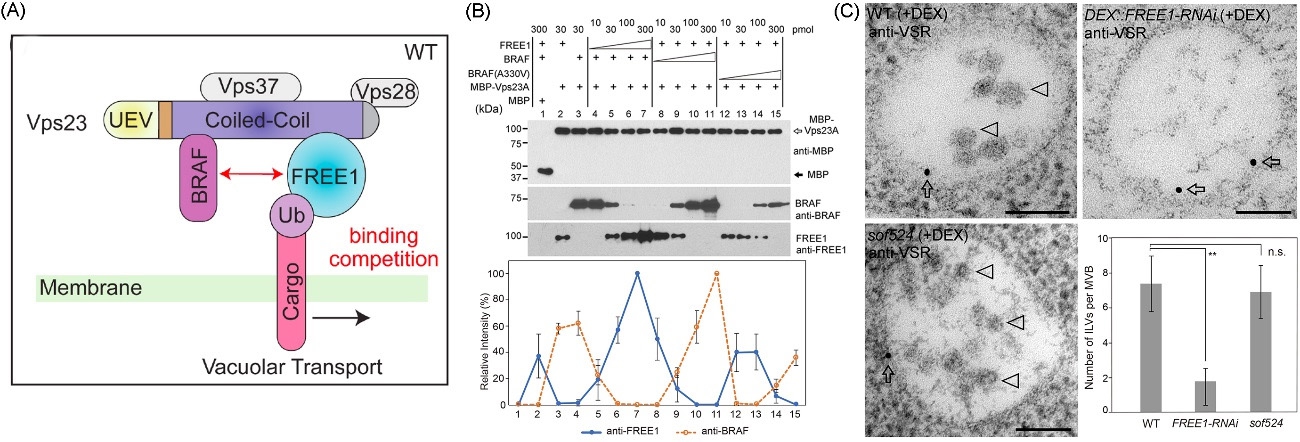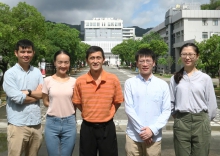CUHK
News Centre
Major Progress Made in Plant Multivesicular Body Biogenesis and Membrane Protein Vacuolar Transport by CUHK Researchers Providing New Insight into Improving Crop Quality
A team of researchers at The Chinese University of Hong Kong (CUHK) led by Professor JIANG Liwen, Choh-Ming Li Professor of Life Sciences, has recently made a major breakthrough in revealing in plants a unique negative regulator for plant Multivesicular Body (MVB)/Prevacuolar compartment (PVC) biogenesis and membrane proteins vacuolar transport.
The team has newly identified a novel role and mechanism for plant-specific BRAF (BRo1-domain protein as FREE1 suppressor), which functions as a unique evolutionary endosomal sorting complex required for transport (ESCRT) negative regulator in orchestrating intraluminal vesicle (ILV) formation in MVB/PVCs and the sorting of membrane proteins for vacuolar degradation in plants. The findings have provided new insight into improving crop quality and have been published in Nature Communications.
Plant development, defence, and many physiological processes rely on the ESCRT machinery to control the homeostasis of membrane proteins by selective vacuolar degradation. It is not only essential for the destruction of non-functional or misfolded proteins, but also ensures proper cell signaling and facilitates interactions with the environment.
In higher eukaryotes, the essentialness of the ESCRT machinery in regulating intraluminal vesicles formation in MVBs and ubiquitinated membrane protein sorting is well established. However, the existence of regulators modulating the ESCRT machinery in order to control MVB/PVC organelle biogenesis and maintain membrane protein homeostasis remains largely unclear.
Professor JIANG’s research team has been working on the underlying mechanisms of protein transport and organelle biogenesis in plant cells for more than 18 years at CUHK, and has been internationally recognised as a leading group in the field of plant cell biology. In their previous studies, published in Current Biology in 2014 and PNAS in 2015, they identified a unique plant ESCRT component FREE1 as an essential player in MVB biogenesis and the vacuole degradation of the endocytosed plasma membrane (PM) proteins, indicating the important functions of FREE1 in seedlings development and pathogen defense in crops which specifically interacts with Vps23 to be incorporated into the ESCRT-I complex. In the recent study published in Nature Communications, his research team used a combination of genetic suppressor screening and cellular and biochemical characterisation approaches, and identified a plant-specific Bro1 domain protein BRAF which regulates FREE1 recruitment to the MVB/PVC membrane by competitively binding to the ESCRT-I component Vps23. For example, when increasing degradation of the membrane proteins are required under particular environment stimulation, BRAF protein could regulate more FREE1 recruitment to the MVB/PVC membrane. This study has made a major breakthrough in revealing the novel regulatory mechanism of the ESCRT pathway, which is a conserved and essential cellular process contributing to selective vacuolar degradation of membrane proteins.
Professor JIANG said, “This discovery provides insights into the molecular mechanism of the MVB biogenesis and also into a novel molecular basis for crop improvements. Since ESCRT machinery controls the homeostasis of the many PM-localized hormone receptors, and the regulator BRAF is also conserved in the plant kingdom, such as in rice, maize and soybean, further research on the molecular mechanism of plant BRAF provides new insight into how to improve crop quality to overcome a stress environment or pathogen infection, which have become serious problems in agriculture.”
This study was mainly carried out by five postdoctoral fellows (Dr SHEN Jinbo, Dr ZHAO Qiong, Dr WANG Xiangfeng, Dr GAO Caiji, and Dr ZENG Yonglun) and a Ph.D. student (Miss ZHU Ying) in Professor JIANG’s laboratory. Dr SHEN Jinbo, Dr WANG Xiangfeng and Dr GAO Caiji are all now PI and are Professor in the Zhejiang A&F University, Associate Professor in the China Agricultural University and Professor in the South China Normal University respectively. The project was supported by the Areas of Excellence (AoE) Scheme and Collaborative Research Fund (CRF) of the Hong Kong Research Grants Council, as well as the AoE Centre for Organelle Biogenesis and Function, Centre for Cell and Developmental Biology, and the State Key Laboratory of Agrobiotechnology of CUHK.
Graduate students and postdoctoral researchers supervised by Professor JIANG have received many prestigious awards for their research excellence, including twice the CUHK Young Scholars Dissertation Award, four times the CUHK Postgraduate Research Output Award, twice the Keystone Symposium Scholarship USA, twice the Human Frontier Science Program Long-Term Fellows, once the Thousand Talent Plan of Zhejiang, as well as twice the Thousand Talent Plan of China.
A research team led by Professor JIANG Liwen (middle) of School of Life Sciences sheds new light on the plant-unique ESCRT negative regulator in plant MVB biogenesis and membrane protein vacuolar sorting. (From Left) Dr ZENG Yonglun, Dr ZHAO Qiong, Professor JIANG Liwen, Dr SHEN Jinbo and Miss ZHU Ying.





